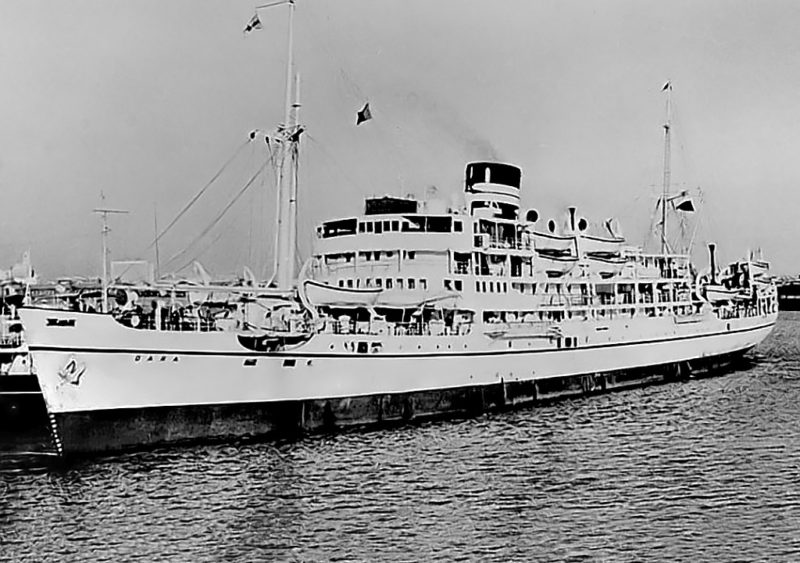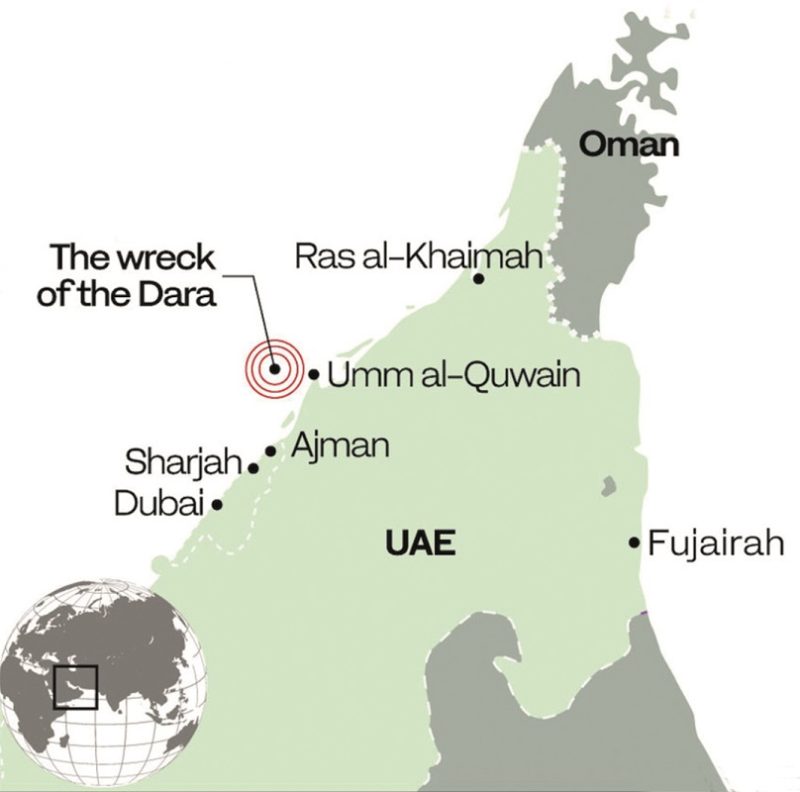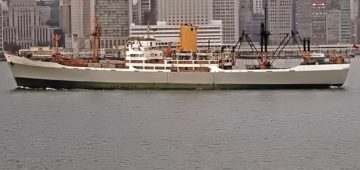Through the eyes of the Junior Cadet

The tragic loss of the passenger ship Dara 62 years ago, was one of the worst peacetime disasters to British shipping since the Titanic. It was made worse because it was a terrorist atrocity, a bomb placed in the second-class accommodation. No one in the United Kingdom seemed interested in the 60th anniversary in June 2021, as though it had never happened. I thought, as the last living officer I should do something, but I was wrong, the chief officer and the assistant purser were still alive! After much thought, and with encouragement from a friend, we flew to Dubai and chartered a motor boat and crew.
We left the Dubai Marina and had a bumpy but fast ride the 30 miles to the Dara wreck buoy, now a cardinal mark, but with Dara written on it. There was no skyline 60 years ago, only desert, but now it is full of high-rise modern buildings.
I scattered flowers in memory of the 238 dead. It was a strange and humbling moment for me. The screaming is no longer in my head, and the spirits of those who died are long gone, as are their remains. The stripped wreck is now a diving site.
I thought back to the day in December 1960 when I had flown out to India, in a BOAC Boeing 707, and joined the Dara in Bombay, an impressionable 17 year-old Junior Cadet.
India was a shock. Nothing I had been taught or heard prepared me, not so much for the heat, I was young and fit, but for the mass of brown humanity, the hot and sweating bodies, the beggars, the noise, the hustle, the bustle and the smell. I had to make a conscious decision not to be frightened, not to be daunted and overwhelmed, if I was to stay in the east. I would have to get used to it.
The Dara was a single screw passenger cargo ship of the British India Steam Navigation Co. permitted to carry 13 first class, 65 second class, 948 unberthed passengers and 132 officers and crew. She was built in 1948 by Barclay Curle, Glasgow, and her length was 382 feet, breadth 55 feet, depth 24 ½ feet, and gross tonnage 5,029. She was classed A1 at Lloyds.

I was thrown in at the deep end shortly after my arrival, when we shifted the ship out of the dock to Ballard Pier, with its great Gateway to India arch. The Junior Cadet’s station was on the bridge manning the telephones, long before the days of walkie-talkies. The Captain, Pilot, Third Officer and myself were all dressed in immaculate whites, wearing caps, hot in the morning heat, the secunnies smart in their white tunics. I passed on the Captains and Pilots orders to the Chief Officer forward and the Second Officer aft and relayed their reports back. Mistakes were not allowed, and I concentrated hard to repeat the messages word for word. It was a long manoeuvre with tugs, along the dock, into the lock, through the harbour and berthing alongside the pier, but it was exciting the first time.
Sailing day was always pandemonium, but organised pandemonium. The departure of the weekly mail ship to Basra was an event. The BI ships were the main way to travel around the Persian Gulf, to some places was the only way, so they were an important link between India, Pakistan, Oman, the Gulf states, Saudi Arabia, Kuwait, Iran and Iraq. The ships were always full of passengers, mainly deck passengers. It was a busy day, with everything seeming to happen at the same time, and the shouts and babble of hundreds of people, men, women, children, servants, the cries of the porters carrying the luggage, huge bundles on their heads., and the street traders hawking their wares.
The Cadets supervised the loading of the mail with the Second Officer. To lose a mailbag was unthinkable. There was a steady stream of humanity coming aboard by the gangways, and shouts and sometimes scuffles as men staked out their part of the deck for the voyage. Of course the more privileged or richer went second-class and had cabins. Europeans were not allowed to travel on deck. First-class passengers came onboard by a separate gangway, where the duty secunny kept watch. The ‘tween decks where the deck passengers lived seemed a form of Bedlam to me on my first Gulf trip. The ship had a couple of holds forward, for passenger baggage and cargo,and the winches worked at full speed, swinging the cargo on board by the derricks, the stevedores sweating in the holds stowing it.
At long last, everyone and everything was onboard, the ship was fully bunkered and watered, and the trip to the money changer completed for there was a nice little earner, exchanging Indian rupees into Gulf rupees, and in the Gulf the other way round.
The Pilot was on the bridge, I was showered and wearing my spotless whites for departure stations, the tugs were made fast fore and aft, the gangways were put ashore, and with much shouting, wailing and waving from the passengers aboard, and the families left ashore, the ship moved off the pier. She was turned, the tugs were let go, and with a last blast on the ships foghorn she steamed out through the busy harbour, crisscrossed by country craft with their ragged sails, or if there was no wind their crews toiling at huge sweeps, all laden with cargo trading up and down the coast, and when the monsoon was fair to East Africa, past anchored ships waiting for a berth, the buildings of Bombay to starboard and so out into the Indian Ocean and up the coast to Karachi. With the north-east monsoon the weather was fine, and it was calm.

Sign-up today to read the full article!
Simply click below to sign-up and read the full article, as well as many others, instantly!





Comments
Sorry, comments are closed for this item